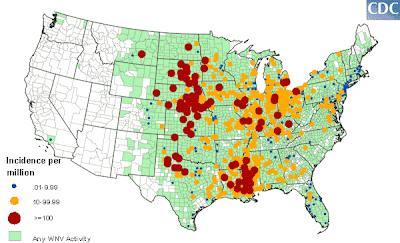Viral Transmission is Science. I said before that Robins are not your innocent backyard birds, and while we are waiting on the blessed event, expected Sunday, I will share with you the dark secret of the Robin.
It seems that they are heavily involved in the spread of West Nile Virus.
CDC West Nile infoPeople are infected with the West Nile virus after being bitten by an infected mosquito. Mosquitoes become infected after taking a blood meal from an infected bird. The virus gets into the bird's salivary glands, and when the mosquito takes a blood meal from a human, say, flipping burgers on the grill in the backyard, the virus is injected into a person.
Now before you barricade yourself inside...even in areas where the disease is spreading, very few mosquitoes carry it and even if an infected mosquito bites there is less than a 1% chance of the person getting the disease and becoming seriously ill.
Look at how the virus spread. Here is the incident map from 1999.

Incident map from 2000. The disease spread fairly slowly that first year.

Incident map of 2001. The disease, while not very prevalent, occurred over a much greater area, including our area of Alabama.

Incident map of 2002. Boom. An explosion of cases across the country.

Here is the 2008 West Nile activity map, with human case numbers for each state. Notice Alabama had 21 cases.
 So what is the Robin's role? It turns out that Robin's are one of the preferred birds for the mosquitoes to feed on.
So what is the Robin's role? It turns out that Robin's are one of the preferred birds for the mosquitoes to feed on.
Not all mosquitoes carry West Nile. Culex mosquitoes are the principle transmitter of West Nile. Culex pipiens is a common mosquito around here. In a 2006 study , researchers found that while robins were less than 4% of the birds in the areas of study, they accounted for 43.4% of mosquito feedings. the researchers found that the virus does well in Robins, and determined that Robins may account for more than 50% of infected mosquitoes. This is important for humans because Robins arrive earlier than many birds, thus epidemics can start earlier in the year. And if Robins leave, the mosquitoes then turn to humans for their food, thus spreading the virus.
Listen to to NPR's "All Things Considered" 2006 report on Robins and West Nile.
But even though Robins hold this dark secret, they are not the bad guys. As long as they are in your backyard, the mosquitoes are less likely to bite you.
To avoid mosquito bites:
Use repellents with DEET, picaridin or oil of lemon eucalyptus.
Wear long sleeves and pants when outdoors. Mosquitoes can bite through thin clothing, so spray the clothing with repellent as well.
Be aware that dusk to dawn are the mosquito's favorite feeding hours.
To reduce mosquitoes:
Drain standing water. Flower pot saucers, bird baths, pet water dishes, buckets and any other container should be emptied and changed at least once or twice a week to interrupt the mosquito life cycle.
Install or repair window screens.
Clean up the neighborhood. Alleys, parks and vacant lots can have containers that hold water and allow mosquitoes to breed.

















































